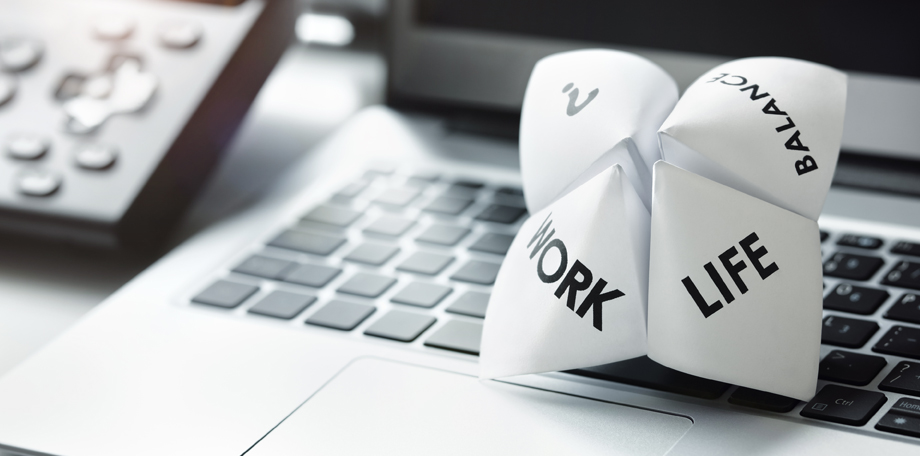Millions of Americans have transitioned from working in an office to their homes during COVID-19, and it will continue that way for a while. Almost 42% of the American workforce continues to work fully remotely right now, and an estimated 27% will still be working from home through 2021, according to Upwork. And this isn’t going to change once the pandemic goes away. A PwC survey of CEOs shows 78% believe that remote collaboration is here to stay for the long-term. In fact, Upwork predicts over 36 million Americans will be working remotely by 2025. That’s a staggering 87% increase from prior to the pandemic!

So how do we achieve work-life balance when our jobs are now happening where we live?
No Separation
One of the problems of working from home is that there is no separation from our home lives and our work lives. Some people are finding that they are more productive because they can multitask and throw in a load of laundry during the workday, and it doesn’t impact their efficiency. They are able to do small tasks around the house throughout the day without losing attention and focus on their work responsibilities.
Other people are finding that they are less productive because there are more distractions at home. This is especially true for parents with children who are at home more. The blurred lines between work and home also remind us of the chores we need to do, and there’s always something else that needs to be done around the house. This can lead to a feeling of overwhelm if you feel as though you can never quite catch up.
Out of Sight Out of Mind
It’s helpful to have physical boundaries when working from home, so if possible, work in a separate area from your living space. Choose an office, basement, or extra bedroom to do your work and literally shut the door and leave that environment once you are done working for the day.
If you don’t have a separate space available, use smaller cues to set boundaries. That could mean shutting down your laptop and removing it from the kitchen table before dinner. Set it up in the morning when you are ready to start working again. By having work materials out of sight when you aren’t working, it can help you actually relax and not fixate on all of the work you have to do.
If you must have your computer or phone near you at all times, shut off your notifications for emails so that you are not being bombarded at all hours.
Set Time Boundaries
It’s also important to set a schedule and stick to it. Determine the hours of your workday and hold yourself to that. It can be easy to work longer hours from home (on average, people are working three more hours a day) but unless there is an emergency, you should be unplugging during off hours and pick up where you left off the next day.
Schedule Breaks
It’s very easy to become engrossed in your work and forget to take breaks. We can now take a few steps to the kitchen to grab lunch and eat it while continuing to work from our desk. While that can be convenient, going straight from task to task doesn’t give your brain the breaks it needs. Spend 10 minutes practicing diaphragmatic breathing exercises, stretching, checking in with your partner or playing with your cat. Small breaks will refresh you and help you maintain productivity during the workday.
Use the Extra Commute Time for Good
Some of us have more time on our hands since we are no longer commuting to the office. It can be easy to use that extra hour to sleep in each morning, but you should try to stick to your normal morning routine as much as possible. Use that extra time to take a walk, work out, catch up on household chores, spend time with your kids, read or get a head start on dinner. Do something that has nothing to do with work during that time.
Have Team Meetings with your Partner
If both you and your partner, spouse or roommate are working from home, it’s helpful to collaborate to organize each day. Have a 10-minute touch base meeting each morning to discuss important calls and meetings and determine a space that can be quiet for those. Divide the workload for errands, cooking meals and household tasks. You can even schedule alternating “days off” from child-care responsibilities to give each other a break. Create joint Google calendars to help manage your time and be aware of what the other person has scheduled.
Create Rituals
When I was a trader, my days were so stressful that I had to create a ritual that would help signal to me that it was the end of the day and time to relax. When I would get home from work, I would remove my trading jacket and take a shower. This was symbolic for me as I was literally washing off the day. It helped me create an emotional distance I very much needed to separate my work life from my home life. Find something you can do at the end of each work day that signals to you the day is done and the evening is yours.
Learn How to Say No
I often give this advice to my coaching clients, but it’s more important now than ever before to be able to say no. Although in-person commitments such as school fundraisers and social gatherings may be less frequent these days, you could be bombarded with virtual requests from friends and family. Space them out so that you don’t feel like you are spending all of your days and nights on Zoom.
Bring Back the Watercooler
Isolation is something that a lot of remote workers have a hard time with. We miss chatting about our favorite Netflix shows with colleagues or sharing pictures of our children. Schedule some fun time with your team to connect on a personal level. It could be as simple as a thread on Slack you check in on daily or you can schedule a virtual meeting. Talking about things other than work helps build relationships and connect with others on a personal level.
Keep Moving
Without chatting at colleague’s desks or stepping out for lunch anymore, you may find yourself sitting at your desk for longer stretches of time. Make sure to make time to get up and move frequently. Apple Watch and Fitbit have reminders you can set to notify you when you’ve been sitting too long, and it’s time to get up and move. It’s a great time to take the dog out for a quick walk or walk up and down the stairs a couple of times.
Related: Master Work-Life Balance
Work-Life Merger
For some people, the past year has been more of a work-life merger rather than achieving work-life balance at home. My Director of Operations and Strategy, Kelly Brummet, who has an 18-month-old son and is now working from home says she’s embracing her new lifestyle. She is now able to spend more time with Jackson instead of driving a long commute and not seeing him for 10 hours a day. Kelly is grateful she’s able to have help at home so she can focus on work during regular hours, but constantly adapts, depending on the day.
“I set up my workspace wherever I need it to be, depending on the day and the task at hand. I like to be able to move around my house. I have a dedicated office for when I need quiet time for longer projects where I’m deep in thought, or obviously for client or team calls/Zoom meetings, but I like to switch up where I work, usually between the kitchen table and counter, but that way I’m able to look up and see Jackson playing with Grandma or give a quick pet to either Rosie the dog or Byfuglien (Buff) the cat. It’s a really nice reminder to hear giggles and the patter of his footsteps running around to put everything in perspective when I get stressed or overwhelmed with the constant emails and spectrum of tasks I’m working on at the same time. It’s also a great quick brain-break to let the dog in and out of the yard!” said Kelly.
Get Support
This new way of working and living takes some adjustment. Be sure to speak up about what isn’t working about your situation with your employer, and be open to hearing feedback from your own team. You may need equipment to make your job easier, or you may be feeling isolated and simply need someone who’s in the same situation to talk to. If your company offers any programs to help manage stress, take advantage of them.
While the lines between work and home may continue to be blended for a while, it’s important to remember to have patience with yourself. If you are feeling overwhelm due to a lack of work-life balance, a coach can help you avoid burnout by working toward achieving harmony between work and life.




